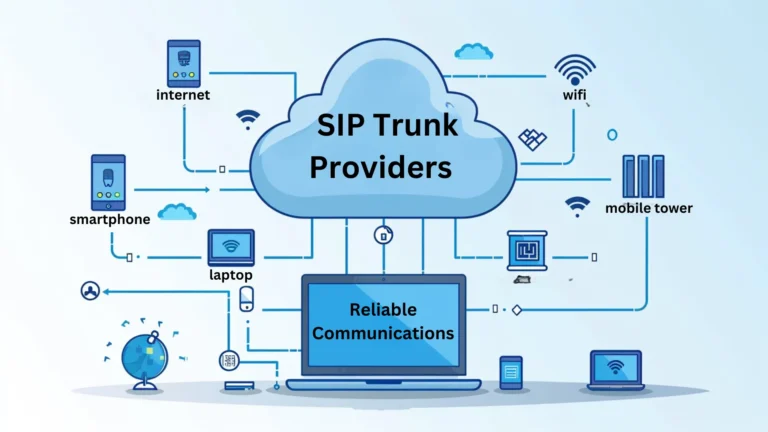Every company relies on communication with customers, suppliers, and teams spread across cities and continents. When the phones go down or the call quality drops, business stops. That’s why more organisations are moving from outdated phone lines to modern internet-based calling with professional sip trunk providers.
The right provider doesn’t just connect calls. It builds the infrastructure that keeps your sales, support, and internal communication running – reliably, securely, and at a predictable cost.
From Legacy Lines to Cloud Voice: The Shift Businesses Can’t Ignore
SIP trunking uses the Session Initiation Protocol to connect your PBX system directly to the public telephone network through the internet. In practice, it’s the digital equivalent of multiple phone lines. Only smarter and easier to scale.
But technology is only half the story. Your provider controls the network routes, manages uptime, and safeguards every call. If they fail, you hear it instantly: in dropped connections and frustrated customers. That’s why choosing a reliable partner is less about features and more about trust.
A good SIP trunk provider keeps latency low, voice quality high, and your teams reachable anywhere in the world.
The Real ROI of SIP Trunking: Why Companies Make the Switch
Companies usually start exploring SIP trunking for one reason: traditional telephony has become too expensive and inflexible. But they stay because of everything else it improves.
- Cost efficiency – Most businesses cut their telecom spending by 35–50% after migration. For instance, KazCall (Kazakhstan) implemented a SIP Trunk for international calls, achieving up to 38% lower communication costs and 43% improvement in call quality with DID Global.
- Scalability – Add new lines or remove idle ones in minutes, not weeks.
- Global coverage – Operate under local numbers in different countries without opening offices.
- Business continuity – Calls automatically reroute if a line or data centre goes down.
- Unified communication – Combine voice, video, and chat in one secure environment.
One global e-commerce brand, for example, used SIP trunks to centralise customer support across five markets, saving thousands monthly while improving response time by 20%.
That’s the real impact of the right provider.
Beyond the Basics: How to Spot a Provider You Can Actually Trust
Not all providers deliver the same quality or transparency. When comparing options, go beyond price and check the fundamentals.
- Network strength – Look for redundant, geo-distributed infrastructure that covers your key regions.
- Voice quality and latency – HD clarity and sub-150 ms delay are the industry standard.
- Integration options – Native compatibility with leading PBX systems, CRMs, and UC platforms, as well as seamless integration with custom-built CRM solutions through API or SIP-based configuration.
- Support and visibility – Real-time dashboards, traffic analytics, and 24/7 human support.
- Number management – Access to local DIDs, emergency routing, and easy number porting.
The best providers act like part of your internal IT team, not just a vendor sending monthly invoices.
Pricing Without Surprises: Understanding SIP Trunk Cost Models
Pricing depends on call volume, regions, and the predictability of your traffic. Typically, you’ll see three main models:
- Per-channel plans – fixed monthly cost per line, suitable for stable workloads.
- Pay-as-you-go – flexible billing for seasonal or project-based operations.
- Hybrid plans – a balance between predictable costs and scalability.
When comparing providers, calculate the total cost of ownership, including setup, support, and international rates. The cheapest option on paper often becomes the most expensive one when downtime hits.
When Security Becomes Strategy: Keeping Voice Networks Safe
Voice traffic may seem harmless, but every call travels through the public internet. That makes encryption and compliance non-negotiable.
Reputable providers use TLS/SRTP encryption, fraud detection, and geo-redundant data centres to keep communication secure. They also follow regional telecom rules and GDPR requirements, protecting both your customers and your brand.
A five-minute outage can cost thousands in lost business. A well-built SIP network ensures that never happens.
Real-World Wins: How Businesses Use SIP Trunking to Scale Smarter
SIP trunking adapts to almost any communication model:
- Startups and SMEs: set up enterprise-level calling without on-site hardware.
- Customer support teams: manage international hotlines from one platform.
- Contact centres: scale to thousands of concurrent calls with intelligent routing.
- Finance and healthcare: ensure encrypted, compliant client communication.
- Global enterprises: unify regional offices and remote teams under a single network.
From a two-person start-up to a multinational with hundreds of agents – the benefits stay the same: lower costs, stronger connectivity, and complete control.
Future-Ready Communication Starts With the Right Partner
Your communication system is the backbone of your business. The right SIP trunk provider helps you keep it strong – stable during peak hours, flexible during growth, and protected from risk.
If your company depends on clear, secure, and scalable communication, it’s worth partnering with a provider who treats uptime as seriously as you treat your customers.
Explore enterprise-grade SIP trunking built for real-world business at DID Global.
Source: DID Global
